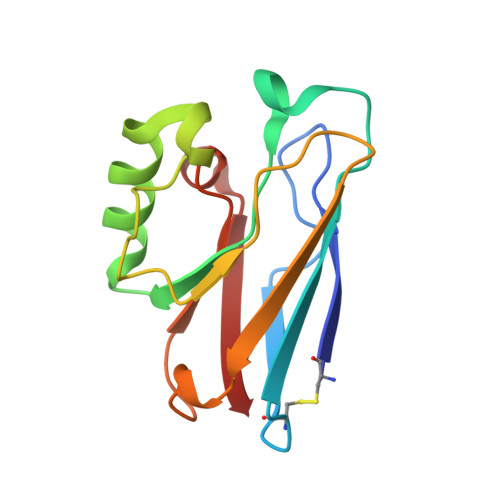Engineering Copper Sites in Proteins: Loops Confer Native Structures and Properties to Chimeric Cupredoxins.
Li, C., Banfield, M.J., Dennison, C.(2007) J Am Chem Soc 129: 709-718
- PubMed: 17227035
- DOI: https://doi.org/10.1021/ja0661562
- Primary Citation of Related Structures:
2HX7, 2HX8, 2HX9, 2HXA - PubMed Abstract:
The ligand-containing loops of two copper-binding electron-transfer proteins (cupredoxins) have been swapped. In the azurin (AZ) variant in which the plastocyanin (PC) sequence is introduced (AZPC), the loop adopts a conformation identical to that in PC. The reduction potential of AZPC is raised as compared to AZ and matches that of PC. In the previously published AZAMI variant (AMI = amicyanin), the shorter introduced loop adopts the same conformation as in AMI, and the reduction potential is lowered to equal that of AMI (Yanagisawa, S.; Dennison, C. J. Am. Chem. Soc. 2004, 126, 15711-15719. Li, C.; et al. Proc. Natl. Acad. Sci. U.S.A. 2006, 103, 7258-7263). Thus, the loop structure plays an important role in tuning the reduction potential of a type 1 copper site with contributions from protein dipoles in this region probably the most important feature. The structure of the loop also seems to be a major factor in controlling dissociation and protonation of the C-terminal His ligand, which can act as a switch to regulate electron-transfer reactivity. The PCAZ variant (PC with the AZ loop) possesses an active site, which is different from those of both PC and AZ, and it is assumed that the introduced loop does not adopt a structure as in AZ. This contributes to the observed instability of PCAZ and highlights that loop-scaffold interactions are important for stabilizing the active site of a cupredoxin.
Organizational Affiliation:
Institute for Cell and Molecular Biosciences, Medical School, Newcastle University, Newcastle upon Tyne, United Kingdom.















